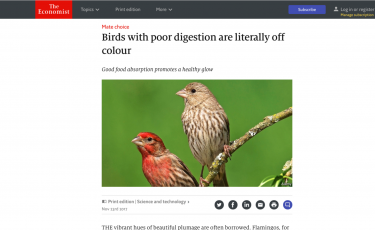The Economist, an influential international weekly magazine-format newspaper, published a study by University of Tartu researcher Tuul Sepp on the colour of House Finch plumage. As a result, the young researcher’s study will reach more than 1.5 million readers.
Tuul Sepp, a post-doctoral student at the University of Arizona, describes The Economist’s great interest in the research as being a surprise to her team:
‘My colleagues and I were contacted personally by Matt Kaplan, a journalist for The Economist. I am still somewhat surprised that this study caught their interest, as it was only a short article published in a well-known and respected journal, although not one that is among the most influential in my specialty. It is possible, however, that the brief nature of the article, its simplicity and easily understood results whetted the journalist’s appetite towards the material.’
In the United States, researchers have a much more difficult time making their way into national media than in Estonia. According to Sepp, it couldn’t be said that her American colleagues are significantly more active when it comes to popularising science. Even so, publication in The Economist is also an event on the other side of the ocean, one that the university there is sharing with pride in all media channels.
How does science that reaches millions of readers come about?
‘I actually arrived at this research topic through a small side project that is part of my primary research. Last winter, I went about catching city birds – house finches – to band them and assess their ability to survive in city and rural habitats. My goal was to prove that birds are better able to survive in cities than in rural areas. Since I had already caught the birds, I thought that before releasing them I could collect some additional data. Members of my Estonian work group, led by Peeter Hõrak and Richard Meitern, had just developed and published a new method for measuring the effectiveness of digestion in birds by analysing the fat content of faeces samples. It seemed simple enough to collect faeces samples from birds and to photograph them in order to analyse their plumage.
Interestingly, no one has yet been able to find an exhaustive answer to the question of why some birds have brighter plumage than others. Birds obtain the pigments that provide the red and yellow tones of their feathers from their food, and my idea was to test whether the efficiency of digestion plays a role in the development of colour. It became evident that digestion is more efficient in brighter coloured birds, i.e. they are better able to acquire the necessary nutrients from consumed food. This study is in fact a good example of how, in many ways, conducting research is an unpredictable process that requires flexibility, because new and exciting discoveries may not come from where the researcher initially expects them to appear’, said Sepp, describing the exciting events in retrospect.
The article published in The Economist.
The translation of this article from Estonian Public Broadcasting science news portal Novaator was funded by the European Regional Development Fund through Estonian Research Council.
 Back
Back



